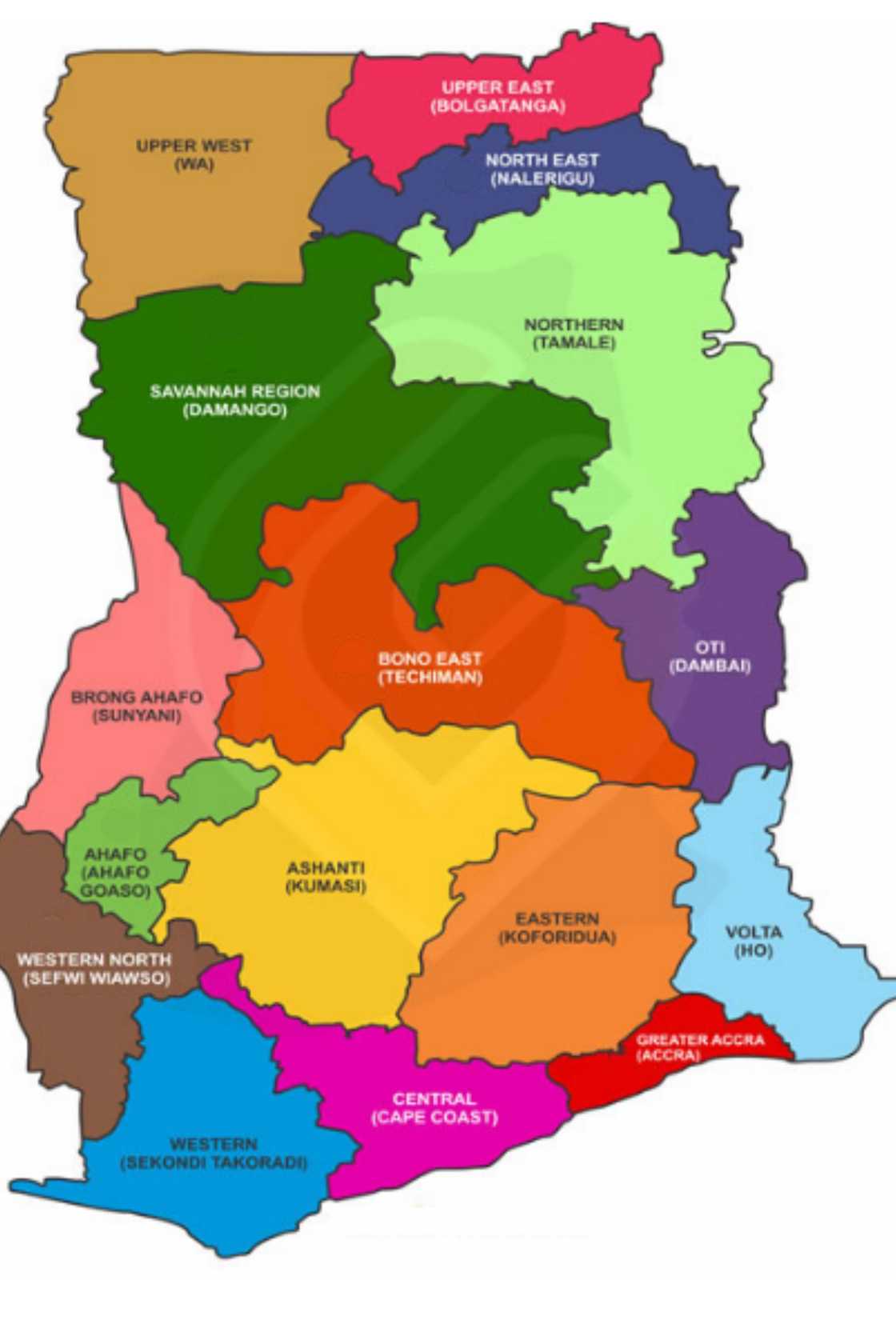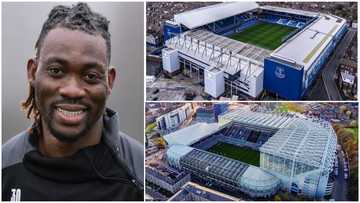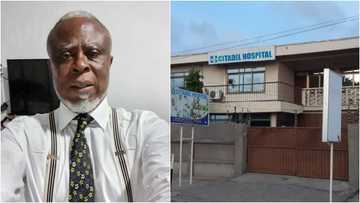All 16 regions in Ghana and their capitals: Complete guide
The establishment of the 16 regions of Ghana and their capitals has put an end to numerous petitions dating back to 1954. This occurred on Tuesday, February 12th, 2019, under the presidency of President Nana Akufo-Addo.

Source: UGC
TABLE OF CONTENTS
Ghana had to hold a referendum in some parts to carve new regions. This was after the president promised his people a better governship from within in 2016 when he was campaigning. All areas had 90 per cent or more approval from their beloved citizens.
16 regions in Ghana and their capitals
What are the 16 regions in Ghana? The table below lists them and their capitals.
New Region | Capital |
Ashanti | Kumasi |
Bono | Sunyani |
Bono East | Techiman |
Ahafo | Goaso |
Central | Cape Coast |
Eastern | Koforidua |
Greater Accra | Accra |
Northern | Tamale |
Savannah | Damongo |
North East | Nalerigu |
Upper East | Bolgatanga |
Upper West | Wa |
Volta | Ho |
Oti | Dambai |
Western | Takoradi |
Western North | Wiawso |
What are the 16 regions of Ghana and their capitals?
The regions in Ghana and their capitals are as illustrated below;
1. The Brong Ahafo Region
- Capital: Sunyani
- Area: 39,557 square kilometres
- Population: 2,310,983
- Subdivisions: 21 districts
Which region in Ghana is the biggest? This region is the first largest among the regions of Ghana and their capitals. The region is located adjacent to the Black Volta River to the north and Volta Lake toward the east. It was established by Bono State in the year 1958. The residents of the area are the Akans, Brongs, and Ahafo.
2. Savannah Region
- Capital: Damongo
- Area: 35,862 square kilometres.
- Population: 581,368
- Subdivisions: 6 districts
Savannah is the second largest of the 16 regions in Ghana. This came to effect on February 12th 2019, after President Akufo-Addo, presented the Attestation document. Damongo is the capital of the new area. Islam is the most popular religion in the area. It has six districts: Bole, North Gonja, Sawla-Tuna-Kalba, West Gonja, East Gonja Municipality, and The Central Gonja.
3. The Northern Region
- Capital: Tamale
- Area: 25,448 square kilometres
- Population: 2,479,461
- Subdivisions: 26 districts
The Northern Region's capital city is Tamale, and around 75% of the financial movement is in agriculture. Yet, shockingly, The Northern Region is considerably drier than others in the list of regions in Ghana.
4. The Ashanti Region
- Capital: Kumasi
- Area: 24,389 square kilometres
- Population: 4,780,380
- Subdivisions: 30 districts
This region is among the biggest with Kumasi as the capital city. The area is significantly known for the gold bar and cocoa generation, which is the biggest fare that the country gives.
5. Bono East Region
- Capital: Techiman
- Area: 22,952 square kilometres
- Population: 649,627
- Subdivisions: 11 districts
Bono East Region is a new region created from the existing Brong Ahafo. The Northern part borders the area to the north, on the east is the Volta Lake, by the west is the Bono area and on the South is the Ashanti part.

Read also
Model Africa Union: 2 GH girls win best speakers at 2023 event in South Africa, photos emerge
6. The Eastern Region

Source: Instagram
- Capital: Koforidua
- Area: 19,323 square kilometres
- Population: 2,633,154
- Subdivisions: 26 districts
The region sits beautifully on the eastern side of the country. The Akans are the principal tenants of the area, and Ewe and English are the real dialects in this region. The Eastern Region is home to the Akosombo dam, one of the biggest dams in the continent supplying power to its occupants.
7. The Upper West Region
- Capital: Wa
- Area: 18,476 square kilometres
- Population: 868,479
- Subdivisions: 11 districts
Situated in the northwest segment of Ghana, it is the most youthful locale to be made with its capital town as Wo. The region has the most modest number of inhabitants among all regions of Ghana.
8. The Western Region
- Capital: Sekondi – Takoradi
- Area: 13,842 square kilometres
- Population: 2,060,585
- Subdivisions: 22 districts

Read also
2 NSMQ boys from St James honoured in Gambia after placing 1st & 2nd in WASSCE, Ghanaians react with joy
The Western Region is one of the wealthiest regions. In June 2017, expensive unrefined petroleum was found in the area. The locals also do gold mining (small/large scale) happens.
9. The Central Region
- Capital: Cape Coast
- Area: 9,826 square kilometers
- Population: 2,201,863
- Subdivisions: 17 districts
The Central Region was ideal for harbouring many slaves. Notably, enslaved people were sent to this district to work, and they left after the subjection period was over.
10. The Volta Region
- Capital: Ho
- Area: 9,504 square kilometres
- Population: 2,118,252
- Subdivisions: 25 districts
With Ho as its capital, this is one of the multi-ethnic and multilingual areas. Notably, the region is home to Ewe, the Guan, and Akan communities.
11. North-East Region
- Capital: Nalerigu
- Area: 9,072 square kilometres
- Population: 575,558
- Subdivisions: 6 municipals
North East area is among the new current regions in the country. It is positioned north of Ghana, and its capital is Nalerigu in the East Mamprusi Municipal. On the north, it borders the Upper East part, on the east lies the Eastern Ghana-Togo international border, on the South is the Northern area, and the west is the Upper West Region. Reminiscent of the rest of the new areas, it was carved out of an existing part of the Northern Region.
Here are the six municipals and assemblies that form up the North-East part. Buyuori Cave, Shrine in Wulugu, Mossi kings in Gambaga, NaYiri Palace in Nalerigu, Gambaga Escarpment, and Savannah are several tourist attraction centres in the region.
12. The Upper East Region
- Capital: Bolgatanga
- Area: 8,842 square kilometres
- Population: 1,046,545,
- Subdivisions: 13 districts
The region locale is situated on the northern sides of Ghana. It is the second smallest among the 16. The capital city is Bolgatanga, which is generally alluded to as (Bolga).
13. Oti Region

Source: Instagram
- Capital: Dambai
- Area: 8,502 square kilometres
- Population: 742,664
- Subdivisions: 8 districts
Oti Region is one of the six newly formed regions. President Nana Akuffo-Addo declared its administrative capital as Dambai. It is situated at the centre of the Northern region, Volta Region, and Volta Lake which is among the largest man-made lakes in the globe. The region is inhabited by various tribes that engage in trading, fishing, farming, and raising cattle.
14. Ahafo Region
- Capital: Goaso
- Area: 5,193 square kilometres
- Population: 564,536
- Subdivisions: 6 districts

Read also
Stamford Bridge, Estádio do Dragão and 2 other top European stadia where Christian Atsu played
President Akufo-Addo said Goaso is the capital of the Ahafo Region. They are to receive GHC 20 million as the initial money for development reminiscent of new regions across the republic.
15. The Greater Accra Region
- Capital: Accra
- Area: 3,245 square kilometres
- Population: 5,455,692
- Subdivisions: 16 districts
Accra, which is also referred to as the Port City, is a money-making hub and the capital of the country. It has the highest number of residents among all parts of Ghana with 87.4% of its total population living in urban centres.
16. Western North Region
- Capital: Sefwi Wiawso
- Area: 2,391 square kilometres
- Population: 928,309
- Subdivisions: 9 districts
It lies in the middle of the Central Region, Ivory Coast, the Brong-Ahafo Regions, and the Gulf of Guinea to the South. It is the wettest area among the regions in Ghana and their districts since it receives the highest rainfall.
It is located at the equatorial climatic zone, which is considered to have rational temperatures. The area is home to both Muslims (8.5) and Christians (81%), who are the main religious groups. Sefwi, Akan, French, and English are the core languages spoken in the Western North part.
There you have it, the 16 regions in Ghana and their capitals. Ghana is considered a stable country in the west of Africa which is among the peaceful ones on the continent.
READ ALSO: Top 10 tallest NBA players of all time and their career stats
Yen.com.gh recently published an article on the top 10 tallest NBA players of all time and their career stats. National Basketball Association (NBA) has continuously drafted and signed tall and athletes.
Even though some of the best NBA players of all time like Michael Jordan, LeBron James, Kobe Bryant and Larry Bird were not 7 foot NBA players, they played the game perfectly and set records that have lasted decades since they left the game. So which player is the tallest in NBA history? Take a look at this article to find out more.
Source: YEN.com.gh





